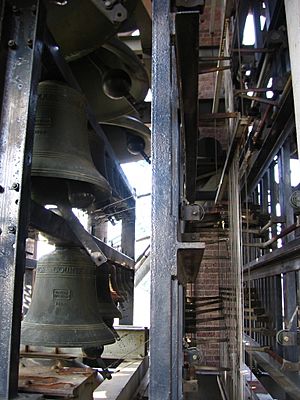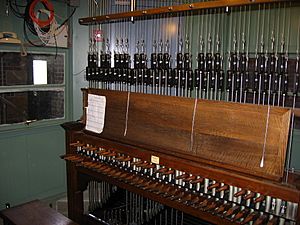Yale Memorial Carillon facts for kids
The Yale Memorial Carillon is a special musical instrument. It has 54 bells and is located in Harkness Tower at Yale University in New Haven, Connecticut. A carillon is like a giant piano, but instead of hammers hitting strings, a player uses a keyboard and pedals to make clappers hit bells.
The 54 bells are arranged to play many different notes. They cover 4.5 octaves, which is a very wide range! The biggest bell is very heavy, weighing over 13,000 pounds. Each bell has special engravings. These include the year it was made, the mark of the company that made it, the Yale University symbol, and the motto "For God, For Country, and For Yale."
How the Carillon Started
Harkness Tower and the area around it were a gift to Yale University. This gift was from Anna M. Harkness. She gave it to remember her son, Charles William Harkness.
The tower first had only 10 bells. This smaller set of bells was called the Harkness Memorial Chime. A chime has fewer bells than a carillon. These first bells were made in 1921 in Loughborough, England. They were made by a company called John Taylor Bellfounders.
The bells were put in Harkness Tower in 1922. The first time they were played was on June 9, 1922. For many years, the university organist played the chimes. Then, in 1946, a student named Elliot H. Kone took over. When he graduated in 1949, he started a student group. This group was called the Guild of Yale Bellringers. They made sure the bells were played regularly.
More Bells Added
In 1966, the instrument got much bigger! An amazing 44 more bells were added. This was possible because of a gift from Florence S. Marcy Crofut. These new bells were also made by the John Taylor Bellfounders.
With the new bells, the instrument became a full carillon. It could play many more notes, covering 4.5 octaves. It was then named the Yale Memorial Carillon. This new name honored both the Harkness and Crofut gifts. The student group also changed its name to the Yale University Guild of Carillonneurs.
Before the new bells arrived, a practice carillon was installed. This allowed students to learn the new instrument. The practice carillon has a keyboard and pedals just like the real one. But it uses small metal bars instead of huge bells. This means students can practice without making a sound that can be heard for blocks! A second practice carillon was added in 2006.
You might hear a story that Harkness Tower was once the tallest stone building. And that it needed to be fixed because someone poured acid on it. This is a fun story, but it's not true! The Washington Monument has always been taller. The tower actually needed to be made stronger in 1966. This was because of the extra weight of all the new bells. A steel frame was added inside to hold them up.
Playing the Carillon Today
Students who are part of the Guild play the carillon twice a day. This happens when classes are in session. During the summer, they play in the evenings. From September to May, you can hear the bells at 12:30 p.m. and 5:30 p.m.
In the summer, the Guild also holds special concerts. Guest carillon players come to perform on Friday evenings. Students also offer free tours of the tower. You can arrange a tour through the Guild's website.
Every fall, students at Yale can learn to play the carillon. They can try out for a spot in the Yale University Guild of Carillonneurs. Students go through a five-week training program. Experienced Guild members teach them. The best students are then invited to join the group. They get to play the carillon regularly for everyone to enjoy!



